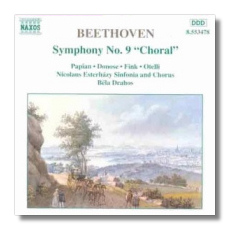
The Internet's Premier Classical Music Source
Related Links
- Beethoven Reviews
- Latest Reviews
- More Reviews
-
By Composer
-
Collections
DVD & Blu-ray
Books
Concert Reviews
Articles/Interviews
Software
Audio
Search Amazon
Recommended Links
Site News
 CD Review
CD Review
Ludwig van Beethoven

Symphony #9 "Choral" Op. 125 (1824)
Hasmik Papian, soprano
Ruxandra Donose, mezzo-soprano
Manfred Fink, tenor
Claudio Otelli, bass-baritone
Nicolaus Esterházy Sinfonia & Chorus/Béla Drahos
Naxos 8.553478 DDD 64:55
I must say that my cup scarcely runneth over at the prospect of yet another Beethoven Ninth to review. One reason being that a first-rate performance of this great work is something of a draining experience and I find it hard to listen critically to the work more than once a week at the most, so finding the time to judge a brand new recording adequately can be problematic.
However, this is not just another new Beethoven 9, it is the closing installment in what may very well be the last complete Beethoven symphony cycle to be undertaken this century; the record companies – or their accountants – having finally realised that the market is not exactly undersupplied with Beethoven symphony recordings.
So this disc probably has a certain historical significance. But is it any good?
Decidedly yes. I haven't heard all of the other issues in Drahos's Naxos cycle, but what I have heard has seemed solid and reliable, if uninspired. This Ninth, though, completely surpasses what I've heard and establishes Drahos as a Beethoven conductor with something to say.
The timing of the movements shows that Drahos is, broadly speaking, in the same camp as the period performance crowd; but this is a modern-instruments recording and also, it seems to me, falls within the broad tradition of Beethoven performing stretching back to Niksich's 1913 Fifth. Drahos may well be trying to hear the work afresh, but he evidently has no intention of treating the music as a mere exercise; this performance leaves the listener in no doubt that matters of great import – apart, that is, from the conductor's ego – are afoot.
The tempos generally are on the quick side, beginning with a first-movement opening whose string triplets are not only clearly audible – Furtwängler would not have approved! – but which also generate a propulsive momentum which informs the entire movement. Moreover, the climax is as cataclysmic as it surely should be, and all too often is not.
The scherzo is wonderfully trenchant and as rhythmically powerful as any. The slow movement – Drahos weighs in at 13:05 – is not so quick as to skate the surface of the music, which is one area in which (in my opinion) Hogwood, Norrington and Eliot Gardiner all fall seriously short of the ideal. It cannot be denied, though, that it is possible to penetrate even further; for this you have to search out the old faithfuls: Furtwängler, Klemperer (the EMI video not the studio recording) to name just a couple.
Drahos also presents us with a superb finale; his conception of this may not be the cosmic vision of a Brüggen, but it is certainly a vivacious and joyful affair, with some spirited singing.
The soloists are more than adequate, although none really stands out; the Nicolaus Esterházy Sinfonia and Chorus both acquit themselves well. I particularly enjoyed the vital and characterful playing of the winds, although it must be admitted that their enthusiasm sometimes gets the better of their intonation (try the second movement trio and listen to the oboe to hear what I mean).
Naxos have also given us one of their best orchestral recordings to date: clear and detailed, with a fine sense of the ambiance of the hall.
Even if you already have numerous accounts of The Ninth, this one is well worth investigation.
Copyright © 1997, Deryk Barker


















